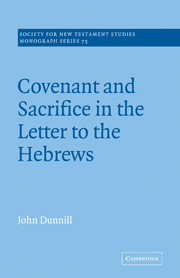Book contents
- Frontmatter
- Contents
- Preface
- List of abbreviations
- A NOTE ON TRANSLATIONS
- Introduction: Hebrews and historical criticism
- Part I Sociology
- Part II Structuralism
- Part III Renewing the covenant
- 4 A liturgy for the Day of Salvation
- 5 The narratives of the covenant
- 6 The testing of the Son of God
- 7 The necessity of blood
- 8 Worship in the new covenant
- Conclusion
- Bibliography
- Index of passages quoted
- Index of modern authors
- Subject index
6 - The testing of the Son of God
Published online by Cambridge University Press: 07 January 2010
- Frontmatter
- Contents
- Preface
- List of abbreviations
- A NOTE ON TRANSLATIONS
- Introduction: Hebrews and historical criticism
- Part I Sociology
- Part II Structuralism
- Part III Renewing the covenant
- 4 A liturgy for the Day of Salvation
- 5 The narratives of the covenant
- 6 The testing of the Son of God
- 7 The necessity of blood
- 8 Worship in the new covenant
- Conclusion
- Bibliography
- Index of passages quoted
- Index of modern authors
- Subject index
Summary
The rich traditional materials relating to Abraham and Isaac were set out in the last main section of the previous chapter according to the associational method being employed there. It was argued that, for Hebrews, the developed tradition of the Akedah provides not only an important symbol of faith-discipleship, in the person of Abraham, but also a symbol of a non-expiatory covenant-sacrifice, in which the mysterious birth of Isaac is fused with his ‘death and resurrection’ into a composite symbol which is central to the letter's presentation of the faith-life of the covenant-people. The purpose of this chapter will be to take up that motif again and to develop the argument, this time through an analysis of its character as ‘myth’, in order to show that the Akedah gives also a basis for the letter's Christology.
The argument will proceed in three stages. First, it will use a method of myth-interpretation borrowed from Lévi-Strauss to present the Akedah as the mythos of covenant-sacrifice in inter-testamental Judaism (developing the point made earlier), and an important element in the Christology of the New Testament; second, it will show how the New Testament (and Hebrews in particular) appropriated the related concept of the ‘seed of Abraham’ in its understanding of salvation; and third, it will show by exegesis of specific passages that this myth and the concepts it carries with it are foundational for the Christology of Hebrews.
- Type
- Chapter
- Information
- Covenant and Sacrifice in the Letter to the Hebrews , pp. 188 - 226Publisher: Cambridge University PressPrint publication year: 1993

